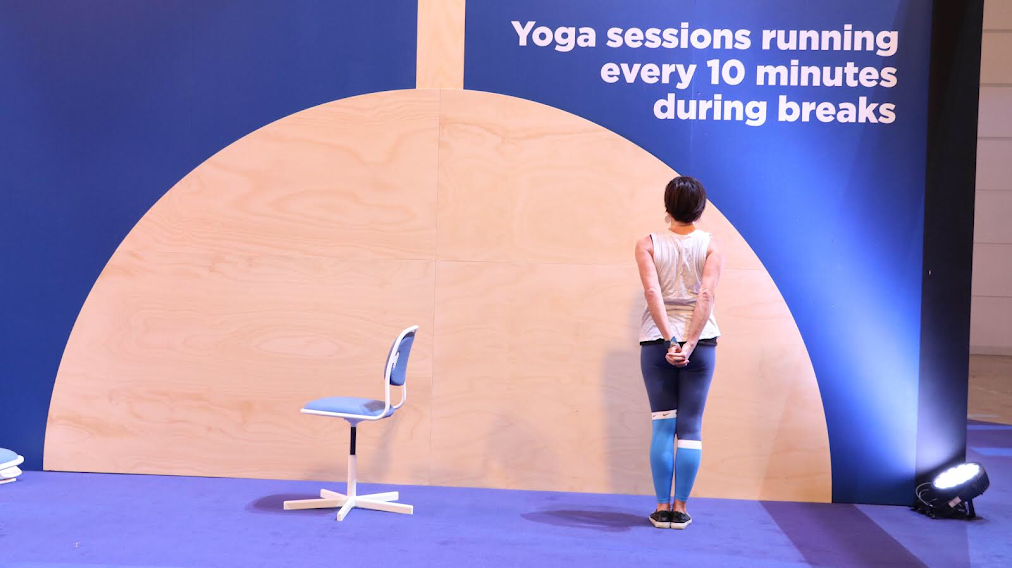10 Tips to Successfully Introduce Yoga at Work
Yoga doesn’t have to be a traditional ‘roll out a yoga mat’ practice
How to bring accessible wellbeing into the workplace
Supporting employee wellbeing doesn’t have to be complicated or costly. It just needs to be thoughtful and accessible. Creating a positive culture around wellness often comes down to small, consistent steps and a willingness to try new approaches.
Wellbeing is fast becoming a key part of organisational strategy, and a simple yet powerful option many workplaces are embracing is yoga.
Why? It’s an affordable way to support both mental clarity and physical health, helping employees feel better, focus more, and bring their best selves to work.
Why Yoga at Work
Yoga isn’t just stretching, although that’s a welcome relief if you spend long hours at your desk. It’s a combination of movement, breath, and mindfulness that reduces stress, sharpens focus, and boosts energy.
Sessions can be tailored for any size workplace, with mats, or simply using chairs, making it accessible to everyone. Beyond movement, yoga also brings meditation, breathwork, and mindfulness: tools that enhance wellbeing and resilience.
Even one class a week can lift energy, improve mood, and strengthen team culture.
Shirt regular sessions hold alot of benefits
Key benefits of workplace yoga:
Reduces stress and tension
Boosts focus, clarity, and productivity
Improves energy and positivity throughout the day
Strengthens team morale and workplace culture
Provides practical tools for wellbeing that staff can use anytime
The real challenge? Making it welcoming for those who think yoga isn’t “for them” and creating an experience that keeps people coming back.
Integrating Yoga with a wide range of wellbeing strategies is a wonderful way to engage a wide rannge of employees
10-Step Checklist for Workplace Wellbeing
Your 10 Steps to Success
Secure Leadership Buy-In
Encourage senior leaders to participate. When leadership shows up, it sets the tone.Gauge Employee Interest
Run a survey to find out what staff want, when they’re available, and how comfortable they feel with different formats.Find Something for Everybody
Frame movement as part of a wider wellbeing initiative that welcomes everyone. This could include mindfulness sessions, Pilates, stretch breaks, guided meditation, and options like lunch & learn talks, quiet zones, resilience workshops, financial wellbeing seminars, or nutrition sessions.By offering variety, you give every employee a way to take part — no matter their interests, abilities, or schedules.
Choose the Right Teacher
Partner with a provider who understands workplace needs and can adapt sessions to all levels.Run a Trial Class
Test the waters with a one off session. Promote it through posters, emails, or your internal platforms.Nominate a Wellness Champion
Recruit someone passionate about wellbeing to keep the momentum going and encourage participation.Set a Schedule That Works
Before ir after work can be good options, but only if people don’t have to rearrange their whole day to get there.The best uptake usually happens when sessions are held in office hours, as a mid morning, mid afternoon or lunchtime break or as a short reset in the afternoon.
Work With Your Budget
Explore funding funding models that suit your organisation: including company support, employee co payment options, cheaper online options or local business partnerships.Offer Incentives
Boost engagement with small rewards like healthy lunches, coffee vouchers, juices or wellbeing hours.Create a whole culture of care
Wellbeing at work isn’t just about offering a yoga class or a once off initiative. It’s about creating a company wide culture of care.When employees feel supported in all aspects of their day, engagement and wellbeing naturally follow.
Here are ways to layer initiatives and build that culture:
✨ Learning & Growth
Lunch & Learns, financial wellbeing workshops, guest speakers on resilience, nutrition, and stress management.
✨ Health & Vitality
Onsite health check-ups, flu vaccinations, skin checks, sound baths, and access to wellbeing specialists.
✨ Supportive Spaces
Quiet rooms for recharge, green spaces, sustainability initiatives (ride to work days, waste reduction), and social connection hubs.
✨ Everyday Wellbeing
Walking meetings, access to healthy snacks and drinks, hydration stations, and regular reminders to move.
✨ Inclusive Challenges
Steps, push ups, hydration, or mindfulness challenges that get everyone involved.
✨ Connection & Culture
Gratitude boards, peer recognition, wellbeing champions, and community volunteering days.It’s not about one big event, it’s about consistent touchpoints that make wellbeing feel part of the fabric of the workplace.
Taking opportunities ti rest with sound baths and meditation can be very powerful
The real benefit comes when wellbeing is woven into the very fabric of workplace culture, in an environment that feels supportive, values people, and invites open dialogue.
A single initiative like yoga can be powerful, but the lasting impact comes from creating a range of opportunities for employees to care for both their body and mind.
That might look like:
Yoga, Pilates, and movement sessions to energise the body
Short mindfulness or stretch breaks woven into the day
Lunch and Learns on topics employees are genuinely interested in
Sound baths or guided rest sessions to recharge and reset
Financial wellbeing programs and health check ups to support whole person wellness
Regular feedback opportunities so employees can share what matters most to them
When wellbeing is offered in different ways, it meets people where they are, whether they’re drawn to movement, relaxation, learning, or practical life tools. This approach not only reduces stress and improves focus but also strengthens morale, deepens engagement, and helps build a workplace culture where people truly thrive.




